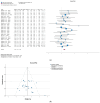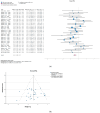The Ability of AST-120 to Lower the Serum Indoxyl Sulfate Level Improves Renal Outcomes and the Lipid Profile in Diabetic and Nondiabetic Animal Models of Chronic Kidney Disease: A Meta-Analysis
- PMID: 39728802
- PMCID: PMC11679735
- DOI: 10.3390/toxins16120544
The Ability of AST-120 to Lower the Serum Indoxyl Sulfate Level Improves Renal Outcomes and the Lipid Profile in Diabetic and Nondiabetic Animal Models of Chronic Kidney Disease: A Meta-Analysis
Abstract
The therapeutic benefit of the oral adsorbent drug AST-120 in chronic kidney disease (CKD) is related to an indoxyl sulfate (IS)-lowering action. Diabetes and dyslipidemia might worsen kidney damage in CKD. However, it is not known whether AST-120 influences lipid abnormalities as well as renal function in patients with CKD and diabetes. The objective of the present meta-analysis was to evaluate the efficacy of AST-120 treatment in CKD using data from preclinical studies. Mixed-effect or random-effect models were used to estimate the standardized mean difference (SMD) and the 95% confidence interval (CI). Publication bias was assessed with a funnel plot and Egger's test. The potential influence of some variables (the dose and duration of AST-120 treatment, the animal species, and the CKD model's diabetic status) was evaluated in subgroup analyses. Treatment with AST-120 was associated with a significantly lower IS level in animals with CKD (SMD = -1.75; 95% CI = -2.00, -1.49; p < 0.001). Significant improvements in markers of renal function and the lipid profile were also observed. In subgroup analyses of the cholesterol level, the diabetic status, the AST-120 dose, and the animal species were found to be influential factors. AST-120 lowered serum IS and triglyceride levels and improved renal function in animal models of CKD independent of diabetes status. However, AST-120's ability to lower the total cholesterol level was more prominent in animals with diabetic CKD.
Keywords: AST-120; cholesterol; chronic kidney disease; diabetes; indoxyl sulfate; meta-analysis; mouse; rat; renal function markers; triglyceride.
Conflict of interest statement
H.O.A. and E.K. declare no conflicts of interest. Z.A.M. reports having received grants for CKD-REIN and other research projects from Amgen, Baxter, Fresenius Medical Care, GlaxoSmithKline, Merck Sharp & Dohme-Chibret, Sanofi-Genzyme, Lilly, Otsuka, AstraZeneca, Vifor, and the French government, as well as fees and grants to charities from AstraZeneca, Boehringer Ingelheim, and GlaxoSmithKline.
Figures










Similar articles
-
Synbiotics, prebiotics and probiotics for people with chronic kidney disease.Cochrane Database Syst Rev. 2023 Oct 23;10(10):CD013631. doi: 10.1002/14651858.CD013631.pub2. Cochrane Database Syst Rev. 2023. PMID: 37870148 Free PMC article.
-
Study on the modulation of kidney and liver function of rats with diabetic nephropathy by Huidouba through metabolomics.J Ethnopharmacol. 2025 Jul 24;351:120136. doi: 10.1016/j.jep.2025.120136. Epub 2025 Jun 11. J Ethnopharmacol. 2025. PMID: 40513925
-
Oral adsorbents for preventing or delaying the progression of chronic kidney disease.Cochrane Database Syst Rev. 2014 Oct 15;2014(10):CD007861. doi: 10.1002/14651858.CD007861.pub2. Cochrane Database Syst Rev. 2014. PMID: 25317905 Free PMC article.
-
Insulin and glucose-lowering agents for treating people with diabetes and chronic kidney disease.Cochrane Database Syst Rev. 2018 Sep 24;9(9):CD011798. doi: 10.1002/14651858.CD011798.pub2. Cochrane Database Syst Rev. 2018. PMID: 30246878 Free PMC article.
-
Angiotensin-converting enzyme inhibitors and angiotensin receptor blockers for adults with early (stage 1 to 3) non-diabetic chronic kidney disease.Cochrane Database Syst Rev. 2023 Jul 19;7(7):CD007751. doi: 10.1002/14651858.CD007751.pub3. Cochrane Database Syst Rev. 2023. PMID: 37466151 Free PMC article.
Cited by
-
Pathogenesis and Therapeutic Perspectives of Tubular Injury in Diabetic Kidney Disease: An Update.Biomedicines. 2025 Jun 10;13(6):1424. doi: 10.3390/biomedicines13061424. Biomedicines. 2025. PMID: 40564143 Free PMC article. Review.
References
Publication types
MeSH terms
Substances
LinkOut - more resources
Full Text Sources
Medical

